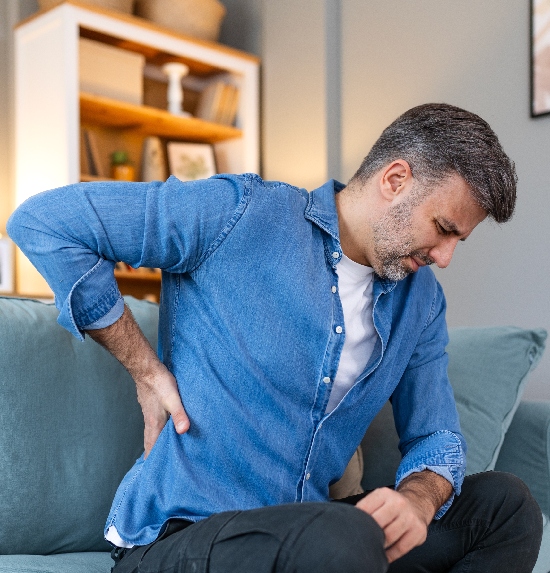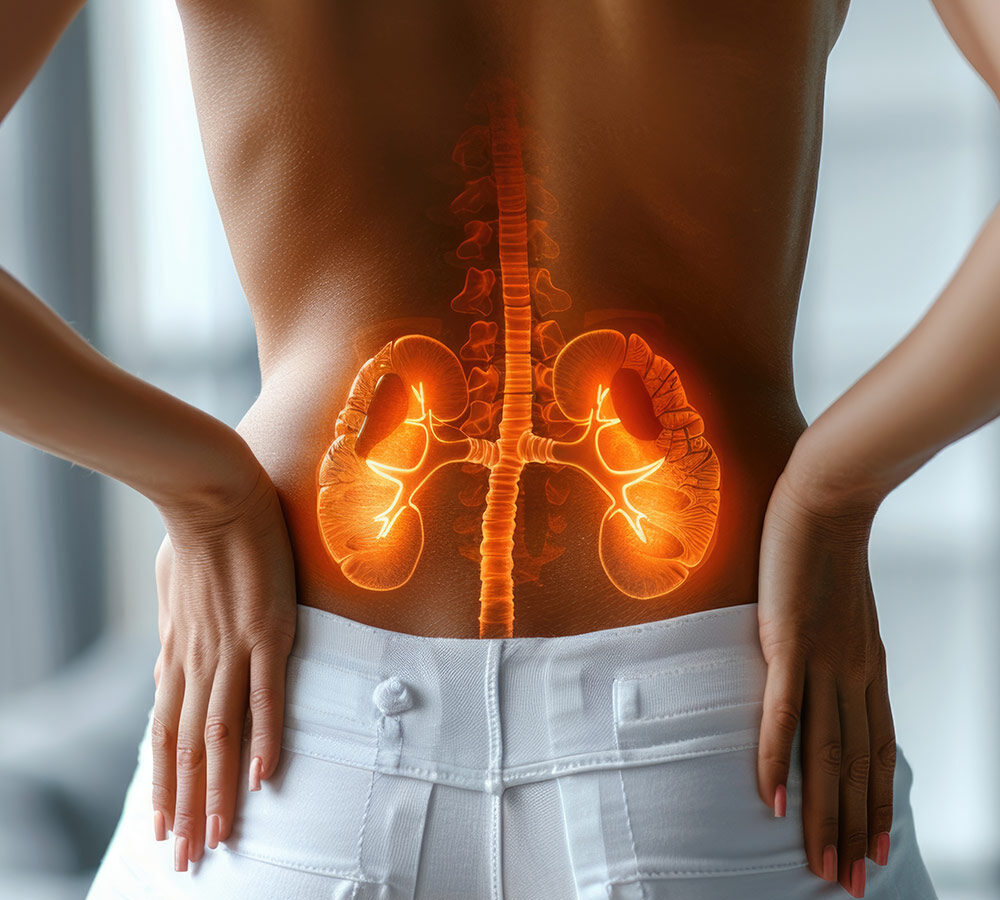
Understanding Urinary Pain
- Kidney stones can form in different parts of the kidney. The size and location of the stone are key in determining the symptoms a patient experiences and how the condition should be managed.1
- Typically, the condition presents with sudden, sharp, cramping pain in the side (flank) that radiates down to the groin. As the stone moves through the ureter, i.e. the tube connecting the kidney to the bladder, the pain may shift to the abdomen, right over where the stone is located, and radiate to the genital area.2
- When a stone blocks the flow of urine, it can cause a buildup of pressure inside the urinary tract and lead to swelling of the kidney. This pressure activates nerve endings in the urinary tract, resulting in colicky pain (painful cramps in the abdomen) and the release of substances that cause pain and muscle spasms in the ureter.1
Causes
Understanding Urinary Stone Formation
- Urinary stones are hard, crystalline deposits that form in the urinary tract of both humans and animals.3
- About 97% of these stones are found in the kidneys and the ureter, while the remaining 3% are located in the bladder and urethra, i.e. the tube that carries urine out of the body.3
- Kidney stones and stones in the upper part of the bladder typically cause pain in the back or side, just below the ribs.4
Passage Through the Urinary Tract
- The likelihood of a stone passing through the urinary tract depends on its location, size, shape and the extent of ureteral obstruction.1
- As stones travel down the ureter, there are 3 narrow areas where they are more likely to get stuck1:
- Where the tube meets the kidney
- Where the tube crosses over major blood vessels
- Where the tube enters the bladder
- If a stone gets stuck in one of these areas, it can cause a blockage.1 As the stone moves through the urinary tract, the pain often shifts, starting in the lower back, then moving to the abdomen, the area between the thighs, and finally to the groin.4
Risk Factors
- The primary cause of kidney stones is a problem with the body’s metabolism, which leads to the formation of stones from insoluble salts.4
- Poor fluid intake can contribute to the problem.3
- Key factors affecting the likelihood of kidney stones include diet habits, the climate and environment where you live, your ethnic background and your family history.3
Lifestyle and Dietary Influences
- Other risk factors involve inactive lifestyles with high consumption of fatty, protein-rich, carbohydrate-rich and purine-rich foods.3
- Additionally, smoking, excessive alcohol use and chronic stress play a role.3
Medical and Genetic Factors
- Additional factors include certain medications, abnormalities in the urinary system, hyperparathyroidism (a condition where the glands in your neck produce too much hormone), lack of vitamins A and D, long-term urinary tract infections (such as kidney infections and bladder infections) and genetic factors.4
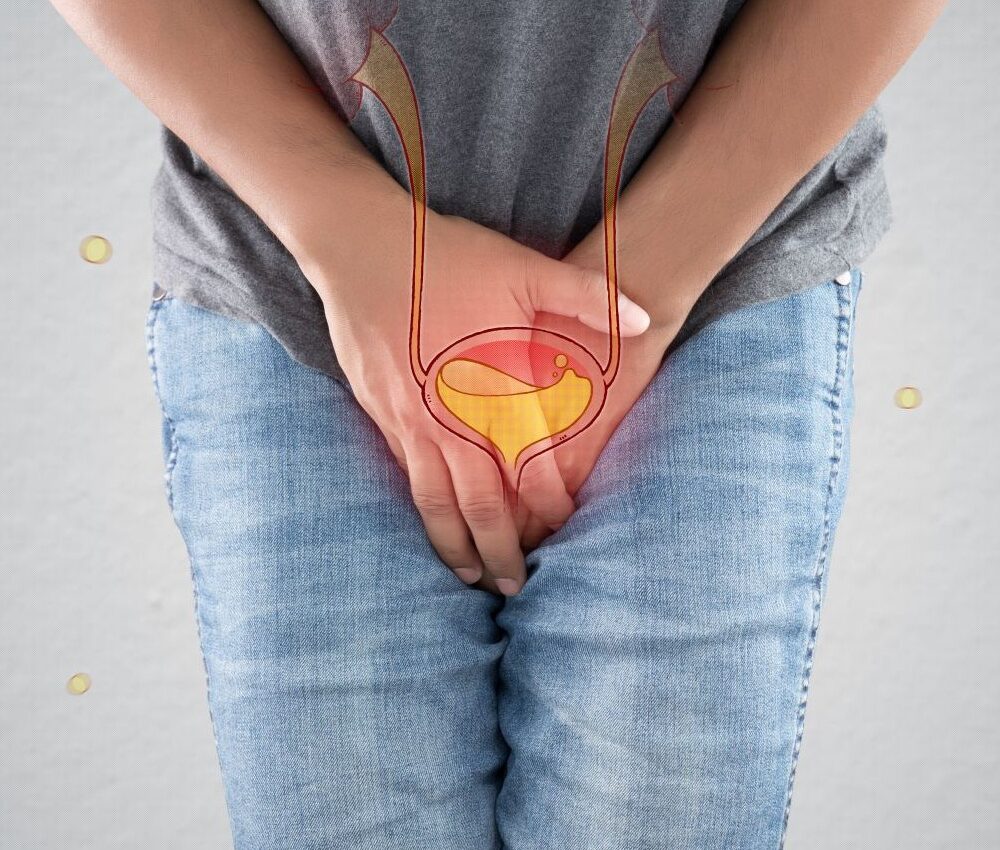

Symptoms
- Patients with kidney stones may experience a variety of symptoms. The most common include pain in the side or lower back, blood in the urine, nausea and vomiting.1
- The pain may change in nature and location depending on where the stone is, though it doesn’t always match the exact spot of the stone.1
- This pain can be severe and intermittent, often lasting for 20 to 60 minutes at a time.4
- It’s often triggered by physical activity, which can cause stress on the body, drinking large amounts of fluids or taking water pills (diuretic medications).4
- In the acute phase, the pain typically comes and goes.1
- If the pain is constant, it could mean the stone is causing a more serious blockage, while on-and-off pain usually indicates a partial blockage. Because the nerves in the gut, urinary system and the body’s movement and sensation areas are all linked, patients may feel pain in places like the intestines, groin, bladder or genitals.1
- Sharp pain in the lower back or abdomen usually occurs before blood appears in the urine. Additionally, cloudy or foul-smelling urine may suggest the stone is moving.4
- Nausea and vomiting are common in about half of the cases.1
- Signs of a urinary tract infection, like the sudden urge to urinate, pain while urinating, frequent trips to the bathroom and pain at the opening of urethra, can also occur as the stone passes through the bladder.1
- Once the stone enters the bladder, symptoms often go away and stones in the urethra typically don’t cause symptoms.1
- If an individual experiences fever, chills or shakes, it could indicate an infected stone, as these symptoms are usually not seen in uncomplicated cases of kidney stones.1
- In such situations, it’s important to see a doctor right away to find out what’s causing the symptoms.4
Diagnosis
- Renal pain is usually caused by a stone blocking the flow of urine. However, the same pain and symptoms can also happen due to issues with the tube that carries urine, which could be caused by other health problems besides kidney stones.5
- Therefore, asking the right questions about the patient’s medical history can help identify more details and assist in diagnosing kidney stones.5
- At least 67% of people with urinary stones experience them again.5
- People with kidney stones, which can cause pain and block urine flow, should be asked about their past experiences with kidney stones, family history of kidney stones, fever, chills, shivering, ability to eat and drink, vomiting, and other urinary problems.1
- A thorough physical examination is important when diagnosing kidney stones.
- The doctor will press on the surface of the body to check the kidney area and the abdomen for any tenderness or pain. After that, a urine test using a test strip (dipstick) should be done.3
- Ultrasound is a useful and non-invasive way to detect kidney stones.3
- If available, a low-dose CT scan of the abdomen is the preferred method for imaging.3

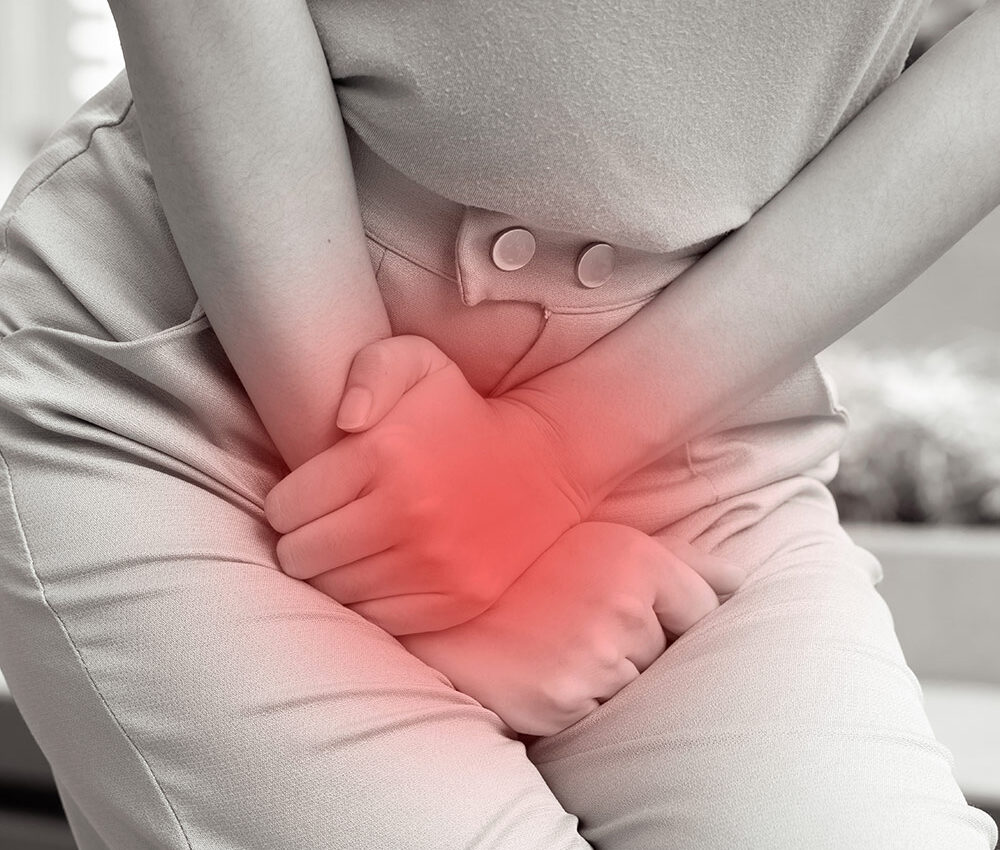
Management
- It’s estimated that nearly half of all people with kidney stones will have another episode within 10 years. While not all risk factors are within our control, making certain dietary changes can help lower the chances of stones returning.1
- People should be advised to reduce their intake of animal proteins, ensuring they still get enough calcium.1
- Drinking plenty of water is also essential; the goal is to drink more than 2 litres of fluids daily to produce over 2 litres of urine each day.1, 2
- Since most people don’t measure their urine output, a handy tip is to aim for clear urine, which indicates proper hydration, rather than yellow.2
- However, it’s important to avoid beverages high in sodium, such as soft drinks. These can raise sodium and calcium levels in the urine, which may contribute to stone formation.2

Track Your Pain Intensity
Understanding your pain is the first step toward effective management. Our Pain Assessment Test Tool is a simple, quick, and interactive way to assess the severity and frequency of your pain. This self-assessment is designed to help you better communicate with your healthcare provider, enabling personalized and timely treatment.
If you’re experiencing chronic discomfort, our tool provides a clear, easy-to-understand analysis that empowers you to take charge of your well-being.
Start the test now to measure your pain intensity and take the first step toward relief!
References:
- Gottlieb M, Long B, Koyfman A. The evaluation and management of urolithiasis in the ED: a review of the literature. Am J Emerg Med. 2018;36(4):699-706.
- Teichman JMH. Acute renal colic from ureteral calculus. N Engl J Med. 2004;350:684-693.
- Fisang C, Anding R, Müller SC, Latz S, Laube N. Urolithiasis—an interdisciplinary diagnostic, therapeutic and secondary preventive challenge. Dtsch Arztebl Int. 2015;112(6):83-91.
- Ikromjon oʻgʻli MM, Shernazarov F. Causes, symptoms, diagnosis and treatment of kidney stones (urolithiasis). Int Sci J. 2022;1(8):760-765.
- Abber JC, McAninch JW. Renal colic: emergency evaluation and management. Am J Emerg Med.1985;3(1):56-63.
Other Abdominal Pain
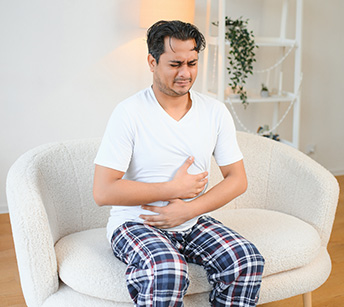
Stomach Pain
Recognize the different types of stomach pain to understand when to seek medical help.

Irritable Bowel Syndrome (Chronic)
Abdominal pain that is experienced for atleast 1D a week for 3 months.
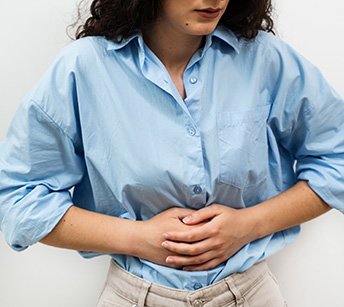
Menstrual Pain
The pain affecting individuals in their menstrual cycles typically centred in the lower abdomen
Colic (Chronic)
The sharp and localized abdominal pain that increases and then decreases in intensity.
01 Urinary Pain
A sudden, sharp, cramping pain in the side that is experienced due to kidney stone.
02 Renal Pain
The intense pain caused by a blockage in the ureter, typically due to a kidney stone.
03 Intestinal Colic
The cramping pain that comes and goes when the intestines attempt to push through a blockage.
04 Biliary Colic
A common type of upper abdominal pain caused by gallstones.
